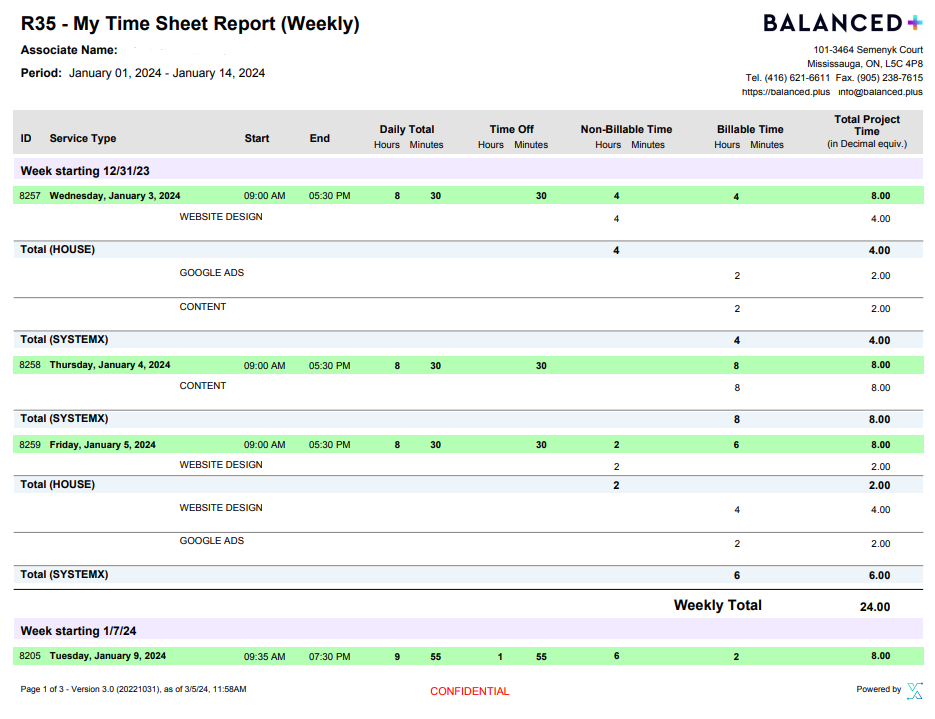In today’s workplace, accurate time tracking is essential for businesses of all sizes. If you aren’t familiar with the concept, a timesheet is the cornerstone of this process. Let’s dive into what timesheets are, why you need them, and how they streamline operations.
What Exactly is a Timesheet?
A timesheet is a document used to track the hours an employee works. It can be a physical document or more commonly, digital software. Timesheets help you:
- Calculate accurate payroll: Timesheets ensure employees are paid the correct amount for hours worked.
- Track project time: See how long employees spend on specific projects, vital for client billing and resource management.
- Analyze productivity trends: Understand how your team uses their time, spotting areas for improvement.
Components of a Standard Timesheet
While timesheets can vary in complexity, some common elements include:
- Employee Information: Name, employee ID, department.
- Pay Period: The dates the timesheet covers.
- Date: Each specific workday within the pay period.
- Project/Task: What the employee worked on.
- Start and End Times: The times the employee began and finished work.
- Break Times: Tracks lunch and other breaks taken.
- Total Hours: Total daily and weekly hours.

Why is Time Tracking so important?
Timesheets offer a win-win situation for both businesses and employees.
For businesses, timesheets ensure accurate payroll calculations, eliminating errors and disputes. This translates to increased efficiency and cost savings. Timesheets also allow for improved billing by tracking project hours precisely. This ensures clients are billed accurately, maximizing profitability. In addition, timesheets provide transparency for employees. With a clear record of their work hours, employees feel secure knowing their time is accounted for.
From a productivity standpoint, timesheets are a valuable tool. By analyzing timesheets, businesses can identify areas where inefficiencies are lurking. This allows for adjustments to work processes, ultimately leading to a smoother workflow and a more productive team.
Finally, timesheets play a key role in project cost control. By tracking the time spent on specific projects, businesses can gain valuable insights into project costs. This allows for better budgeting and resource allocation.
Tips for Using Timesheets Effectively
Choosing the Right Format
The first step to using timesheets effectively is selecting the right format for your needs. Paper timesheets might work for a small team, but digital spreadsheets or time tracking software offer greater flexibility and data analysis capabilities for larger businesses. Consider the size and technical know-how of your team when making this decision.
Designing a User-Friendly System
Once you’ve chosen a format, design a system that minimizes friction for employees submitting timesheets. This could involve features like intuitive interfaces for digital tools or clear instructions for paper forms. The easier it is for employees to submit timesheets, the more likely they are to do so accurately and on time.
Establishing Clear Policies
Outlining clear expectations for completing timesheets and meeting deadlines is essential. This policy should include how timesheets should be submitted, when they are due, and what to do in case of errors or missed punches. A clear policy ensures consistency and reduces the risk of errors.
Regular Review and Analysis
Regular review of timesheets is crucial for catching errors and addressing any productivity concerns promptly. Managers should review timesheets for accuracy and completeness. They can also identify trends that suggest areas for improvement, such as inefficiencies in workflows or unbalanced workloads.
Leveraging Automation
Whenever possible, leverage automation to streamline the process. Time tracking software can automate tasks like sending reminders to employees to submit timesheets, generating reports, and integrating data with payroll systems. This saves valuable time and reduces manual work for both employees and managers.
Get Started with Timesheets
Implementing timesheets is a valuable investment for your business. If you’re not already using them, start researching the best options for your company size and industry. You’ll quickly experience the benefits of streamlined time tracking, payroll, and project management.
If you’re looking to improve your company time tracking, book a quick demo with one of our specialists and see how our timesheets can improve your billing efficiency by up to 30%!

